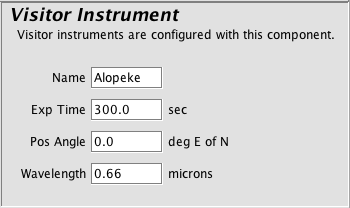Announcements
Phase II observations should be set up using the Template Observations included in your program. These will be filled in with the targets and observing conditions from the Phase I proposal and will include blank observations for the point source standards for speckle observations.
Observing Strategies (Phase II Set-up)
Speckle:
Speckle imaging at Gemini traditionally consists of 1-minute integrations comprised of 1000 images of 60 msec each using a 256x256 pixel (2.5") subarray which closely matches the isoplanatic patch size. These observations are normally taken during set blocks of time when the NASA speckle team takes the observations. If time is required for special events (for example, planetary stellar occulations), we encourage you to get in contact with the support team.
To set up Speckle Phase II observation in the OT, simply apply the template to the observations that you presumably submitted in Phase I. Contact the support team for questions about this.
We ask that PIs also include a note at the top of the program titled either "`Alopeke Observing Note" or "Zorro Observing Note" depending on which instrument is being used. In this note, we ask that PIs detail the configuration you want for your observations, i.e. what filters you want used, if you want different exposure times per target than what is normally done, if you want a certain number of sets per target, etc.
Wide-Field:
In wide-field mode 'Alopeke and Zorro typically read out the full frame using the conventional amplifier at 1MHz. It is also possible to bin, read out a subarray, or use the EMCCD amplifier for faster readout, or read more slowly (0.1 MHz) for lower read noise. See the EMCCD page for the full list of readout options.
We ask that PIs also include a note at the top of the program titled either "`Alopeke Observing Note" or "Zorro Observing Note" depending on which instrument is being used. In this note, we ask that PIs detail the configuration you want for your observations, i.e. what filters to use, what exposure time is needed, and any other items of note.
Overheads
Every group of speckle targets within 15 degrees and/or every hour must include a point source standard. A photometric standard must be included once/night when doing photometry.
Acquisition overheads associated with setting up on each new target include time for slewing the telescope, configuring the guiding, and centering the target. This is already included in the OT calculation and is added to every observation.
Point source standards (bright stars known to be single) will be observed at each sky location with a minimum of one per hour for speckle imaging. These take ~10 minutes (including acquisition overheads). Groups of science targets closer than ~15 degrees may share point source standards. If PIs want to provide them, this is allowed. Otherwise, the NASA speckle team will choose standards for the PIs targets. If the later option is chosen, PIs do not need to add point source standards to their program.
Programs wishing to do photometry must include 10 minutes (including acquisition overheads) per night per photometric calibrator (wide binaries).
Filter changes add ~1 minute of overhead.
| Action | Overhead (min) |
| Acquisition | 5 |
| Point Source Standard | 10 |
| Photometric Standard | 10 |
`Alopeke and Zorro OT Details
This page explains how to configure the Gemini "Visitor Instrument" component for use with 'Alopeke and Zorro

Name
The Visitor Instrument name should be set to "Alopeke" in the case of 'Alopeke, and "Zorro" for Zorro
Exposure Time
The "Exp Time" field should be filled in with the total desired integration time for each target.
Position Angle
The "Pos Angle" field sets the position angle of the instrument on the sky (degrees East of North). It is not expected that this field will be used with 'Alopeke given the circular field of view.
Wavelength
The "Wavelength" field is used by the TCS to calculate the relative atmospheric dispersion with respect to the guide wavelength, and should be set midway between the two filters, typically ~0.66um.
Phase II Checklist
Instrument Configuration
- The Instrument Name should be "Alopeke" for GN and "Zorro" for GS
- The Observing Tool has no mechanism to specify the instrument configuration (dichroic & filters), so please include a note with this information.
- The "Exp Time" should be the total desired integration time
- The Wavelength should be between the two imaging filters, typically ~0.66um
Target Coordinates
- Must be accurate to better than 1 arcsecond
- Must include proper motions
Guiding
- 'Alopeke and Zorro observations must be guided using PWFS2
- The OT will attempt to find a guide star automatically. If this fails the "Auto" guide star group will be empty, in which case you should use the "Manual GS" button to search for another which will not vignette the science target. Please email your Contact Scientist if you have any questions.
Standards and Calibrations
Speckle observations must include a point source standard for each sky location, with a minimum of one per hour. Please include a photometric calibrator if photometry is required.
Finder Charts
If the field centering will not be obvious please include a finder chart showing the desired field center and orientation.